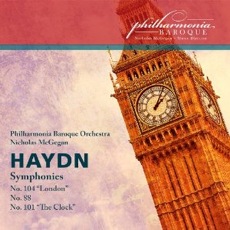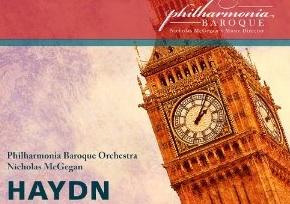
There are many ways to play Haydn badly, and really only one way to play him well. Anyone who’s heard much bad Haydn playing can name the two main paths to ruin: Treat the music as frippery, or solemnize it into a sort of musical statuary. The real Haydn disappears, either way.
The key to Haydn is that it’s serious fun. There’s always uncertainty, often danger, in one of Haydn’s plots; and there’s always humor. Understress either element and you go wrong.
Bay Area audiences may not know how good they’ve had it in the Haydn arena. There was the New Esterházy Quartet’s exhaustive survey of the Haydn quartets, “done right.” There was once Bruno Weil’s annual Haydn symphony at the Carmel Bach Festival, for those willing to make the drive. And then there’s the Philharmonia Baroque Orchestra, and Nicholas McGegan. The orchestra has just issued a disc of live performances (from 2007 to 2009) of Symphonies 88, 101, and 104.
Listen To The Music
Symphony No. 101: I. Adagio - PrestoPurchase Recording


A portion of each purchase helps
support San Francisco Classical Voice
McGegan “gets” Haydn as very few do. The verve and the subtlety of inflection are pretty much a given with this orchestra, but the savagery with which the players light into the darker parts of these scores bespeaks conductorial incitement.
The result is authentic Haydn. I use no quotation marks, because the instruments used don’t have much to do with it, nor does anything else having to do with by-the-book performance practice. (The tangy woodwind and brash brass on this CD certainly don’t hurt, but they aren’t the key to these performances.)
What matters is just that business of treating the music as intensely serious and yet letting it laugh. That endless canon in the finale of No. 88 has never seemed such a harried chase, nor the darkness of No. 101’s introduction so intense. The music’s abrupt changes of mood actually shock, as they were meant to, though they haven’t done so in most performances for a long time. The movement that gave “The Clock” its nickname is a case in point: I had cataloged it mentally as a piece of Haydn drollery, and certainly the beginning and the faux-pompous ending are that. But there are, shall we say, significant events in between.
And to all and sundry: This is how you play a Haydn minuet. Listen and learn.
These are concert recordings, meaning that imperfection unavoidably creeps in. The woodwind intonation, in particular, is a bit dicey in places. Still, if you want to hear three of Haydn’s finest symphonies played with complete understanding and great skill, this ought to be your first stop.

